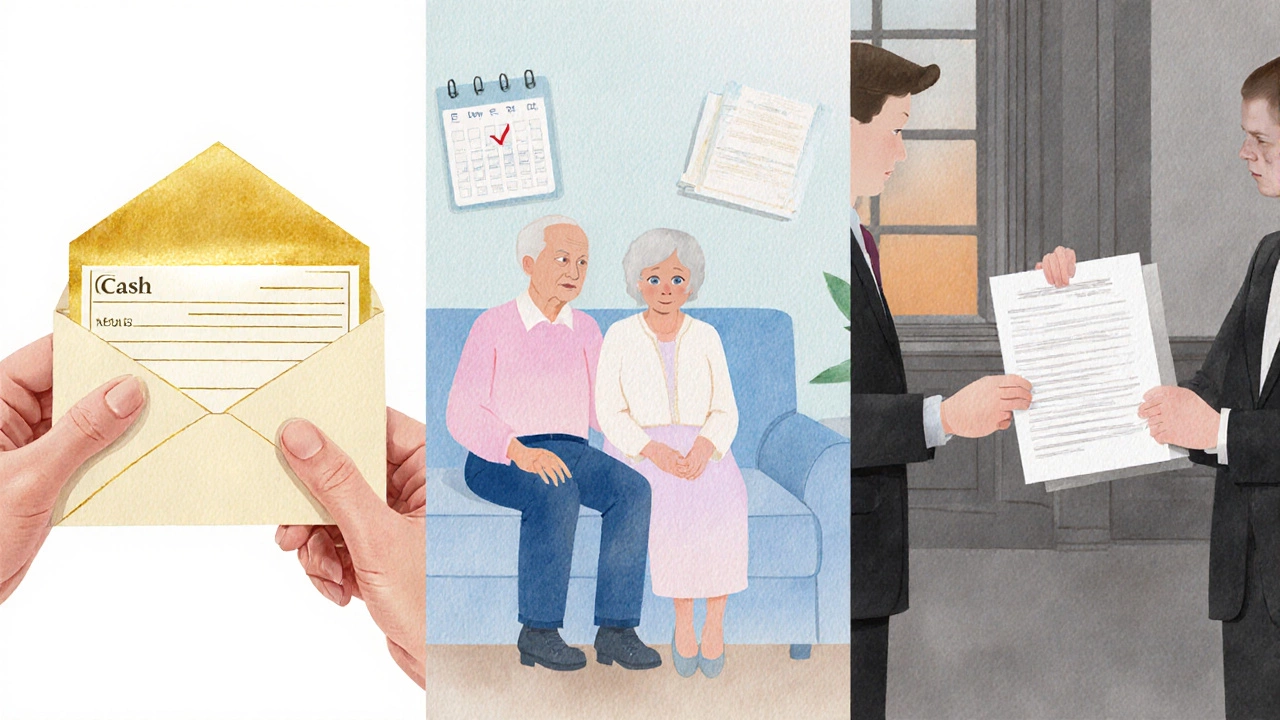Australian Pension Death Benefit Calculator
Lump-Sum Death Benefit
One-time payment to nominated beneficiary
Tax-Free for spouse/childReversionary Pension
Ongoing income for surviving partner
Tax-Free for spouseEstate Payout
Through probate process
Subject to marginal tax ratesDeath Benefit Summary
Quick Takeaways
- Most Australian pensions provide either a lump‑sum death benefit, a reversionary pension for a spouse, or a payout to nominated beneficiaries.
- Tax on death benefits depends on the recipient’s relationship to you and whether the benefit comes from a taxed or untaxed source.
- Claiming a payout requires proof of death, the fund’s claim form, and identification of the eligible recipient.
- Choosing the right beneficiary now can avoid probate delays and extra taxes later.
- Regularly review your superannuation death‑benefit nominations, especially after major life events.
When someone passes away, the way their Pension is a regular income stream usually funded by superannuation that provides retirees with money during retirement is settled can feel confusing. This guide breaks down the main options, who can claim them, and what taxes apply in Australia.
What Happens to a Pension When the Member Dies?
In Australia, most retirees draw their income from an Superannuation Fund that holds their savings in a tax‑advantaged environment. When the fund member dies, the superannuation trustee must decide how to distribute any remaining balance. The distribution follows the rules set out in the Superannuation Industry (Supervision) Act 1993 (SIS Act) and the member’s nomination form.
There are three primary routes:
- A lump‑sum death benefit paid directly to a nominated beneficiary.
- A reversionary (or survivor) pension that continues to pay an income stream, usually to a spouse or a dependent.
- A payout to the member’s estate, which then goes through probate and may be subject to different tax treatment.
Key Types of Death Payouts
| Payout Type | Who Receives It | Tax Treatment | Typical Amount | When Paid |
|---|---|---|---|---|
| Lump‑sum Death Benefit | Spouse, dependent child, or any nominated person | Tax‑free for a spouse or dependent; may be taxable for other beneficiaries depending on source | Whole remaining super balance or a portion set by the fund | Within 30 days of claim approval |
| Reversionary (Survivor) Pension | Spouse or same‑sex partner (if nominated) | Tax‑free for the spouse; taxed if paid to a non‑tax‑free recipient | Continues the existing pension amount, adjusted for any death benefit taken | Starts as soon as the trustee processes the change |
| Estate Payout | Beneficiaries of the will or intestacy rules | Taxed at the beneficiary’s marginal rate unless the super is taxed within the fund | Remaining balance after any other payouts | After probate, which can take weeks to months |

Who Can Receive a death benefit?
The SIS Act defines three categories of eligible recipients:
- Spouse or de facto partner - automatically entitled to receive the death benefit tax‑free if the super is taxed within the fund.
- Dependent child - includes children under 18, full‑time students under 25, and financially dependent children of any age.
- Any other nominated person - the member can name a friend, parent, or charitable organization. Tax treatment varies.
When you fill out a Beneficiary nomination form, you tell the trustee exactly who should get the payout. If you die without a nomination, the trustee follows the default rules (spouse first, then dependents, then estate).
Understanding the Reversionary Pension
A reversionary pension is essentially the same income stream you were receiving, transferred to your surviving partner. It continues until the partner dies, the fund runs out of money, or the partner decides to cash it out.
Key points:
- It only applies to account‑based pensions (not defined‑benefit pensions).
- The surviving partner can usually keep the same payment amount, but the fund may adjust for any lump‑sum taken beforehand.
- Because the income is tax‑free for Australian residents, it’s a popular choice for couples.
Tax Implications of a pension death benefit
Tax rules hinge on two factors: the source of the super (taxed or untaxed) and the relationship of the recipient.
- Taxed source - Most modern super funds are taxed at 15% within the fund. In this case, the lump‑sum is tax‑free for a spouse, partner, or dependent child. Other beneficiaries may pay tax on the taxable component, calculated at their marginal rate.
- Untaxed source - Some public sector or military super schemes have untaxed components. If a non‑spouse receives the benefit, the taxable component is taxed at 45% plus the Medicare levy.
If the payout goes to the estate, the super is taxed at the highest marginal rate (45% + Medicare) unless the fund can allocate a tax‑free component.

Step‑by‑Step: Claiming a Death Benefit
Ready to claim? Follow this checklist to avoid delays:
- Gather required documents - Certified death certificate, proof of identity for the beneficiary, and the member’s superannuation account details.
- Contact the fund - Use the fund’s dedicated claims phone line or online portal. Ask for the specific claim form.
- Complete the claim form - Fill in the beneficiary’s details exactly as they appear on the nomination. If there’s no nomination, indicate the relationship (spouse, child, etc.).
- Submit supporting evidence - Attach the death certificate, ID proof, and any legal documents (e.g., a grant of probate if paying the estate).
- Await the fund’s decision - Funds usually process a claim within 20-30 business days. They may request additional information.
- Receive the payout - The fund will either transfer a lump sum to the nominated bank account or set up a reversionary pension.
Tip: Keep copies of everything and note the claim reference number for follow‑up.
Common Pitfalls and Pro Tips
- Out‑of‑date nominations - Life changes (marriage, divorce, birth of a child) instantly affect eligibility. Review nominations at least annually.
- Assuming probate is needed - A properly nominated beneficiary bypasses probate, speeding up the payout.
- Mixing tax‑free and taxable components - Ask the fund for a breakdown. You may be able to withdraw the tax‑free portion first.
- Choosing the wrong payout type - A lump sum may be preferable for a one‑off need, while a reversionary pension provides steady income for a surviving spouse.
- Ignoring state laws on intestacy - If you die without a nomination, the estate follows state intestacy rules, which can send the benefit to unintended parties.
Frequently Asked Questions
Can I name a friend as a pension beneficiary?
Yes, you can nominate any person, including a friend, on the beneficiary form. However, the death benefit will be taxed at the beneficiary’s marginal rate unless the super is from a taxed source and the beneficiary meets the ‘dependant’ definition.
What if I die without a nomination?
The fund follows the default order set by law: first the spouse or de facto partner, then dependent children, and finally the estate. The estate route can trigger probate and potentially higher taxes.
Is a reversionary pension guaranteed for the surviving partner?
The pension continues as long as the fund has sufficient balance and the surviving partner doesn’t cash it out. It’s not a state‑guaranteed benefit, but most funds honour the reversionary arrangement.
Do I need a lawyer to claim a super death benefit?
Usually not. The trustee’s claim form and the required documents (death certificate, ID) are sufficient. A lawyer may be needed only if the payout goes to the estate and probate is required.
How does a lump‑sum death benefit affect my remaining super balance?
If a lump sum is taken, the balance used to calculate any reversionary pension is reduced accordingly. Some members choose a partial lump sum to keep enough for a survivor’s pension.
Understanding how a pension death benefit works can spare your loved ones from paperwork headaches and unexpected tax bills. Keep your nominations current, know the payout options, and follow the claim steps promptly - that’s the best way to protect the people you care about.






